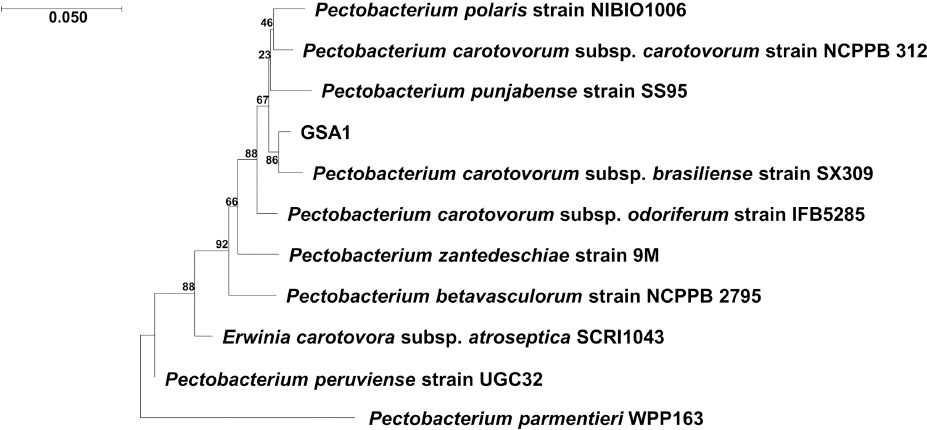As one of the oldest crops, amaranth (
Amaranthus spp.) is domesticated in the Andean region of Latin America about 8,000 years ago (
Rastogi and Shukla, 2013). The amaranth belongs to the genus
Amaranthus and family
Chenopodiaceae, and is classified to three types of grain, vegetable and ornamental type (
Caselato-Sousa and Amaya-Farfan, 2012;
Pandey, 2013;
Tang and Tsao, 2017). Amaranth is recognized as good materials related with nutrients, and has received attention in recent years because of their potential health benefits (
Tang and Tsao, 2017). There are several diseases of amaranth such as leaf blight, damping-off, and root rot (
Celine et al., 2013;
Rastogi and Shukla, 2013).
Pectobacterium spp. cause soft rot and blackleg on various hosts (
Charkowski, 2018). New species had been classified in recent studies such as
P. aroidearum,
P. parmentieri,
P. peruviense, and
P. polaris (
Dees et al., 2017;
Khayi et al., 2016;
Nabhan et al., 2013;
Waleron et al., 2018). In this day,
Pectobacterium spp. are considered as species complex because
Pectobacterium species showed diverse characteristics. Of old collection of
P. carotovorum subsp.
carotovorum, several isolates were re-classified as
P. carotovorum subsp.
brasiliense (Pcb) in South Korea (
Lee et al., 2014). In this study, we aimed to isolate and identify the soft rot pathogen of amaranth in South Korea and identify.
Showing typical symptoms of soft rot disease, amaranth (
Amaranthus caudatus L.) plants were collected from Gangneung, Gangwon province during 2017. Wilting and defoliation were observed on amaranth plant (
Fig. 1A). Inner part of stem had macerated tissue and foul smell (
Fig. 1B). To isolate pathogen, partial stem of amaranth was surface-sterilized for 90 s in 1% hypochlorite solution and rinsed in sterile distilled water. Samples were macerated in 1.5 ml tube and were streaked on Luria-Bertani (LB) agar medium. The single colony was purified by subculture for two times. Bacterial isolates were stored at -72┬░C with 20% glycerol. To test pathogenicity, a representative isolate was grown on LB agar for 16 h at 28┬░C and suspended in 10 mM magnesium sulfate (MgSO
4) solution with an optical density of 0.5 at 600 nm wavelength using spectrophotometer (DS-11, DeNovix, USA). 1 ml bacterial suspension was injected to the stem of five seedlings of 2-week-old amaranth with a needle. As negative control, 1 ml of 10 mM MgSO
4 solution was inoculated to three seedlings of 2-week-old amaranth. Inoculated seedlings were incubated in a chamber with 28┬▒1┬░C, 95% relative humidity for 16 h. Inoculated amaranth seedlings were evaluated after disease symptom developed (
Fig. 1C_left). The control plants didnŌĆÖt show the symptoms (
Fig. 1C_right) of soft rot. To confirm KochŌĆÖs postulates, the bacterium was re-isolated from amaranth seedling. To identify isolated bacterium, 16S rDNA gene and recombinase A (
recA) gene were sequenced by Macrogen, Inc. (Korea). Sequences of 16S rDNA (1,390 bp, Accession No. MH886389) and
recA (668 bp) were compared with the reference sequences using the BLAST software in the GenBank database (
http://www.ncbi.nlm.nih.gov/). With 16S rDNA sequence of Pcb GSA1 strain, we found 99% similarity to those of
P. carotovorum. In the phylogenetic tree (
Fig. 2), isolated bacterium was located in a group comprising a reference strain of Pcb. Based on symptoms, pathogenicity, and molecular analysis of 16S rDNA and
recA, we concluded that the isolated bacterium from soft rot symptom of amaranth is Pcb. To our knowledge, this is the first report of soft rot disease by Pcb in amaranth plant.







